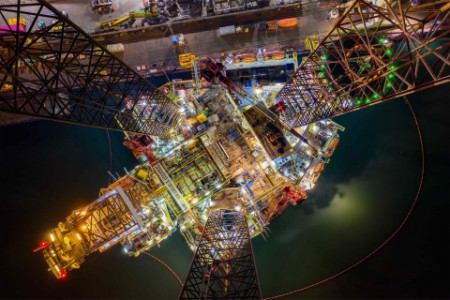The Asia-Pacific region is facing the dual challenge of meeting its growing energy needs and delivering on decarbonization targets. Its rising population, growing economies and industrial expansion will drive energy demand. The region also accounts for more than half of the global energy-related emissions1 and many of its governments have committed to net zero by 2050–70 or earlier.
At the 26th UN Climate Change Conference of the Parties held in November 2021, Indonesia, Vietnam and South Korea, three of the world’s 10 largest coal power-producing nations, pledged to phase out unabated coal power. By switching just 20% of coal-fired power to gas, Asia can potentially avoid 680 million tons of carbon emissions per annum.2 Gas-fired electricity can also help match variable renewable energy supply to its demand and improve grid system reliability and stability.
Gas consumption in the Asia-Pacific region is expected to double to more than 1,600 billion cubic meters by 2050, compared with the 2020 level.3 To meet the growing power demand, the region has a robust pipeline of gas-fired power plants. Gas-fired capacity in Southeast Asia is expected to increase from 98 GW in 2019 to nearly 200 GW by 2050, driven by developments in Indonesia, Vietnam, Thailand and Myanmar.4
Further plans to build US$379b5 of new gas infrastructure in Asia, growing demand for natural gas and declining domestic natural gas reserves will highlight the importance of liquefied natural gas (LNG) interregional and intraregional trade. In Southeast Asia, LNG is likely to become the dominant source to meet gas demand growth. The region is expected to become a net importer of natural gas after 2024, which is when its natural gas demand is forecast to surpass local production.6 The LNG-to-power industry needs to focus on the following fundamentals to thrive.
Tailored financing structure and partnerships
LNG-to-power projects are capital-intensive and require the support of both local governments and regional financiers. In June 2021, for example, the Japanese government announced US$10b in financial aid for decarbonization projects in Asia, including renewable energy and the conversion to gas-fired power generation from coal.
The Asian Development Bank also recently published its energy policy that supports the financing of gas-based power generation in the Asia-Pacific region.7 Additionally, cooperation between LNG producers and regional governments can be instrumental. For instance, The AES Corporation is financing a 2.2GW LNG-fired power project in southern Vietnam.8
Flexible long-term contracts
Over the past two years (as of 3 August 2022), LNG prices in Asia have ranged from a two-year low of about US$2.68/MMBtu to a two-year high of about US$51.76/MMBtu.9 Long-term supply contracts with flexibility such as price indexation and destination clauses are essential to reduce the impact of price volatility. Tying gas pricing in Asia to a local price index that better represents local market realities is another alternative. In September 2021, the Shanghai Petroleum and Natural Gas Exchange unveiled China’s first spot LNG price index, which is backed by state-owned energy companies and the country’s top independent LNG importers.
The need for flexibility in LNG supply contracts is one of the primary concerns hampering the growth of LNG-to-power projects. LNG sellers need a long-term, fixed purchase volume at a market price, but LNG buyers (power projects) rarely get a dispatch guarantee from purchasers of electricity from LNG under power purchase agreements. This is because electricity purchasers are unsure about their long-term demand for electricity from LNG as the future price competitiveness of electricity from renewables and batteries will depend on technological and cost developments in those areas. There is, therefore, a mismatch between the LNG industry and the power industry.
Government support
Investors in LNG-to-power projects face significant risk if there are no government-backed power purchase agreements. A regulatory system is required so that consumer electricity prices adequately reflect the cost of LNG, and power generators should be entitled to government subsidies. In addition, a peak power tariff mechanism can be set up to incentivize gas-based power plants to meet peak demand. Recently, China’s Shandong province proposed a two-part on-grid tariff mechanism for local natural gas-fired power plants to cushion the rising prices.
Third-party access (TPA) to existing infrastructure
To access competitively priced LNG supplies, a flexible and responsive LNG market is critical. For example, Malaysia and Thailand have established a TPA strategy that allows LNG importers without terminals to utilize existing infrastructure. Similarly, a Chinese gas pipeline company recently auctioned medium- and long-term import slots for seven LNG facilities for five to 20 years. TPA allows further gas supply security and improves utilization of existing LNG infrastructure.


